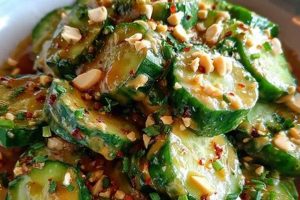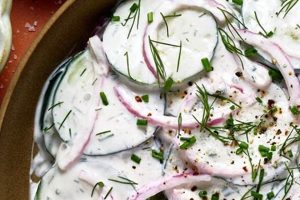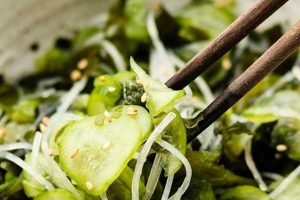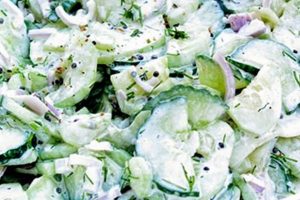Refreshing and crisp, combinations of sliced cucumbers and onions form the base of numerous salads. These salads often incorporate variations by adding other vegetables like tomatoes, bell peppers, or herbs such as dill and parsley. A variety of dressings, from simple vinegar and oil to creamy yogurt-based options, enhance the flavor profile, offering a spectrum of possibilities. A classic example features thinly sliced cucumbers and red onions dressed with a mixture of vinegar, sugar, and a touch of salt and pepper.
These salads are valued for their simplicity, affordability, and nutritional benefits. Cucumbers offer hydration and essential vitamins, while onions provide antioxidants and contribute to flavor complexity. Historically, these simple salads have been a staple in many cultures, particularly during warmer months when refreshing dishes are highly desirable. Their adaptability allows them to serve as a light lunch, a side dish at barbecues, or a complement to richer main courses.
Further exploration will cover specific regional variations, the nutritional breakdown of key ingredients, and detailed preparation methods for different dressings and complementary ingredients.
Tips for Preparing Exceptional Cucumber and Onion Salads
Achieving optimal flavor and texture requires attention to detail throughout the preparation process. The following tips offer guidance for creating a truly satisfying culinary experience.
Tip 1: Ingredient Selection: Opt for firm, unblemished cucumbers and onions. Consider varieties like English cucumbers for their thinner skin and fewer seeds. Red onions offer a pungent bite, while sweeter options like Vidalia onions provide a milder flavor.
Tip 2: Slicing Technique: Uniformly thin slices ensure even marinating and a pleasant texture. A mandoline slicer offers precision, but a sharp knife can also achieve excellent results. Avoid excessively thick slices, which can be less palatable.
Tip 3: Salt and Rest: Salting the cucumbers and onions prior to dressing draws out excess moisture, preventing a watery salad. Allow them to rest in a colander for approximately 15-20 minutes before rinsing and patting dry.
Tip 4: Dressing Choices: Vinegar-based dressings provide a classic, tangy flavor. Experiment with different vinegars like white wine, apple cider, or rice vinegar. Creamy dressings using yogurt or sour cream offer a richer, milder alternative.
Tip 5: Flavor Enhancements: Fresh herbs like dill, mint, or parsley elevate the flavor profile. A pinch of sugar can balance acidity, while black pepper adds a subtle spice. Consider incorporating other vegetables such as chopped tomatoes or bell peppers for added complexity.
Tip 6: Chilling Time: Allow the salad to chill in the refrigerator for at least 30 minutes before serving. Chilling allows the flavors to meld and enhances the refreshing quality of the dish.
By following these guidelines, one can consistently produce a salad that is both flavorful and visually appealing. Careful attention to detail, from ingredient selection to chilling time, ensures a superior culinary outcome.
This foundation of preparation techniques paves the way for exploring more elaborate variations and creative interpretations.
1. Ingredients
Ingredient selection significantly impacts the final flavor and texture profile of cucumber and onion salads. The foundational elements, cucumbers and onions, offer a neutral canvas upon which other ingredients build complexity. Cucumbers contribute a refreshing coolness and subtle sweetness, while onions provide a pungent bite. The choice of onion varietyred, white, or yellowinfluences the intensity of the onion flavor. For example, red onions offer a sharper, more assertive flavor compared to the milder sweetness of Vidalia onions. This foundational flavor combination allows for diverse additions. Tomatoes introduce acidity and juiciness, while bell peppers contribute a crisp texture and subtle sweetness. Fresh herbs, such as dill, mint, or parsley, introduce aromatic complexity.
Beyond the core vegetables, the dressing plays a crucial role. A simple vinaigrette, composed of vinegar and oil, provides a tangy counterpoint to the vegetables’ inherent sweetness. The type of vinegar further nuances the flavor profile. Apple cider vinegar offers a mellow sweetness, while white wine vinegar provides a sharper, more acidic note. Creamy dressings, based on yogurt or sour cream, create a richer, more substantial salad. Adding spices and seasonings, such as black pepper, sugar, or salt, further refines the overall taste. The interplay of these ingredients determines the final balance of sweet, sour, salty, and savory elements.
Careful ingredient selection is paramount to achieving the desired outcome. Fresh, high-quality produce ensures optimal flavor and texture. The balance of ingredients, from the primary vegetables to the supporting elements of the dressing and seasonings, defines the character of the salad. Understanding the interplay of these components allows for customization and adaptation to individual preferences. The strategic use of ingredients transforms a simple combination of cucumbers and onions into a versatile and flavorful culinary creation.
2. Preparation Methods
Preparation methods significantly influence the final texture, flavor, and overall appeal of cucumber and onion salads. From the initial selection and handling of ingredients to the final assembly and presentation, each step contributes to the ultimate culinary outcome. Understanding these methods allows for greater control over the final product, ensuring a consistently satisfying and enjoyable salad.
- Slicing Techniques:
The manner in which cucumbers and onions are sliced affects both texture and flavor absorption. Thin, uniform slices ensure even marinating in the dressing, contributing to a balanced flavor profile and a pleasant mouthfeel. Conversely, thicker slices may result in uneven flavor distribution and a less delicate texture. Precision slicing, achieved with a mandoline or sharp knife, enhances visual appeal. Different slicing styles, such as half-moons, rounds, or ribbons, offer further aesthetic variation.
- Maceration and Salting:
Macerating cucumbers and onions with salt draws out excess moisture, preventing a watery salad and concentrating flavors. This process also softens the texture of the onions, mellowing their pungency. The duration of salting influences the final outcome; a shorter salting time preserves some crispness, while longer salting results in a softer texture. Rinsing and thoroughly drying the vegetables after salting removes excess salt and residual moisture.
- Dressing Incorporation:
The timing and method of dressing incorporation impacts flavor development and overall balance. Adding the dressing just before serving maintains the crispness of the vegetables, while marinating the salad for a longer period allows the flavors to meld. The type of dressing, whether a light vinaigrette or a creamy emulsion, also dictates the appropriate incorporation method. Gently tossing the salad ensures even distribution of the dressing without damaging the delicate vegetables.
- Ingredient Order:
The order in which ingredients are combined can influence the final presentation and flavor distribution. Adding more robust ingredients, such as tomatoes or bell peppers, after the cucumbers and onions have been dressed prevents them from becoming overly saturated and losing their texture. Layering ingredients strategically creates visual interest and allows for distinct flavor experiences with each bite.
Mastery of these preparation methods elevates cucumber and onion salads from simple side dishes to carefully crafted culinary creations. Precise slicing, thoughtful maceration, strategic dressing incorporation, and considered ingredient layering contribute to a superior textural and flavor experience. Attention to these details ensures consistent quality and allows for creative exploration within the framework of this versatile dish.
3. Flavor Profiles
Flavor profiles significantly impact the versatility and enjoyment of cucumber and onion salads. Understanding the interplay of different taste elements allows for tailored recipe development and customization to individual preferences. The inherent neutrality of cucumbers and onions provides a foundation upon which a wide range of flavor profiles can be built. Exploring these profiles unlocks the full potential of this simple yet adaptable dish.
- Tangy & Bright:
This profile emphasizes acidity and freshness. Vinegar-based dressings, often incorporating white wine vinegar, apple cider vinegar, or rice vinegar, create a sharp, invigorating flavor. Lemon or lime juice can further enhance the brightness. Fresh herbs like dill, mint, or parsley contribute herbaceous notes, complementing the acidic foundation. This profile is particularly refreshing during warmer months and pairs well with grilled meats or fish.
- Creamy & Mild:
Creamy dressings, typically using sour cream, yogurt, or mayonnaise, offer a richer, more mellow flavor profile. These dressings coat the cucumbers and onions, creating a smooth, satisfying texture. The addition of herbs like chives or dill adds subtle complexity. This profile offers a milder alternative to the tangy style and complements spicier main courses.
- Sweet & Savory:
Balancing sweet and savory elements creates a more complex and nuanced flavor profile. A touch of sugar or honey in the dressing adds sweetness, while ingredients like toasted sesame seeds or crumbled bacon provide savory notes. This profile offers a versatile option that can be adapted to suit various cuisines and preferences.
- Spicy & Bold:
Incorporating spicy elements adds a kick to cucumber and onion salads. Freshly chopped chili peppers, a dash of hot sauce, or a sprinkle of red pepper flakes introduce heat. Balancing the spice with other flavor components, such as acidity or sweetness, prevents it from overpowering the dish. This profile adds excitement and pairs well with richer, heavier meals.
These flavor profiles demonstrate the adaptability of cucumber and onion salads. By understanding the interplay of different taste elements and incorporating appropriate ingredients, one can create a salad tailored to specific preferences and culinary occasions. From light and refreshing to rich and complex, the flavor possibilities are vast, making this simple salad a remarkably versatile culinary staple.
4. Cultural Variations
Cultural variations significantly influence cucumber and onion salad recipes, reflecting diverse culinary traditions and regional preferences. These variations extend beyond simple ingredient substitutions to encompass distinct preparation techniques, flavor profiles, and serving customs. Examining these cultural adaptations provides valuable insight into the global culinary landscape and offers a deeper understanding of this seemingly simple dish.
In Middle Eastern cuisine, cucumber and onion salads often incorporate fresh herbs like mint and parsley, seasoned with sumac and dressed with lemon juice and olive oil. This reflects the region’s emphasis on fresh, vibrant flavors and the prevalence of these ingredients in local agriculture. Indian variations might include chopped green chilies and a tempering of mustard seeds and curry leaves, showcasing the region’s preference for spicy and aromatic dishes. Mexican cucumber and onion salads, on the other hand, frequently utilize lime juice, cilantro, and sometimes a touch of chili powder, aligning with the country’s characteristic use of citrus and herbs. These examples demonstrate how readily adaptable the basic cucumber and onion salad template is to diverse culinary traditions.
Understanding these cultural nuances allows for greater culinary exploration and appreciation. It underscores the importance of regional ingredients and flavor preferences in shaping seemingly basic dishes. Awareness of these variations expands the potential for creative recipe development, offering opportunities to incorporate diverse flavors and techniques. Further exploration of specific regional adaptations can reveal deeper connections between food, culture, and history, enriching culinary experiences and fostering a greater understanding of global gastronomy. It demonstrates how a simple dish can act as a lens through which to explore broader cultural contexts.
5. Serving Suggestions
Serving suggestions enhance the enjoyment and versatility of cucumber and onion salads by highlighting their adaptability to various culinary contexts. Consideration of appropriate pairings and presentation elevates the perceived value of this simple dish, transforming it from a basic side to a carefully considered component of a meal. Serving suggestions bridge the gap between recipe and consumption, providing practical guidance for incorporating the salad into diverse dining experiences.
As a light and refreshing side dish, cucumber and onion salad complements rich, flavorful main courses, offering a palate-cleansing counterpoint. For example, a tangy vinegar-based cucumber and onion salad provides a refreshing contrast to grilled meats or barbecued dishes. Conversely, a creamy variation complements spicier cuisines, such as Indian or Mexican dishes. The salad can also serve as a standalone light lunch or a component of a larger buffet spread. Its versatility extends to picnics and potlucks, where its refreshing nature and ease of transport make it a practical choice. Presentation also plays a key role; serving the salad in an attractive bowl or alongside complementary dishes enhances its visual appeal and perceived value. Garnishing with fresh herbs or a sprinkle of spices further elevates the presentation.
Understanding appropriate serving suggestions maximizes the culinary potential of cucumber and onion salads. Careful consideration of flavor pairings, meal contexts, and presentation transforms this simple dish into a versatile and appealing culinary asset. This understanding allows for strategic menu planning and enhances the overall dining experience by highlighting the complementary nature of different dishes and flavors.
6. Nutritional Benefits
Nutritional benefits represent a significant advantage of cucumber and onion salad recipes. These salads offer a low-calorie, nutrient-rich option, contributing to a healthy diet. Cucumbers, composed primarily of water, provide hydration and essential vitamins like vitamin K, crucial for blood clotting, and vitamin C, an antioxidant supporting immune function. Onions contribute dietary fiber, promoting digestive health, and contain antioxidants like quercetin, associated with anti-inflammatory properties. The combined nutritional profile of cucumbers and onions makes these salads a valuable addition to balanced meal plans. For example, incorporating a cucumber and onion salad into a lunch routine increases vegetable intake while offering a light, refreshing alternative to heavier, less nutritious options. Understanding the specific nutritional contributions of each ingredient allows for informed dietary choices and recipe adjustments tailored to individual health needs.
Furthermore, the nutritional value of these salads can be enhanced through ingredient selection and preparation methods. Opting for darker-colored onions, such as red onions, increases the intake of anthocyanins, potent antioxidants associated with various health benefits. Minimizing the use of high-calorie dressings, or opting for lighter alternatives like vinegar-based dressings, further optimizes the nutritional profile. Adding other nutrient-rich vegetables, such as bell peppers or tomatoes, expands the range of vitamins and minerals consumed. For instance, incorporating bell peppers introduces vitamin A, supporting vision and immune function. These strategic additions create nutrient-dense meals without compromising flavor or satisfaction.
In summary, cucumber and onion salad recipes offer significant nutritional advantages stemming from the inherent properties of their core ingredients. Maximizing these benefits requires mindful ingredient selection and preparation methods. Understanding this connection empowers individuals to make informed dietary choices, contributing to overall health and well-being. This knowledge further reinforces the value of incorporating fresh, whole foods into daily meal plans. Integrating these salads into a regular dietary regimen provides a simple, accessible, and flavorful pathway toward improved nutritional intake.
Frequently Asked Questions
This section addresses common inquiries regarding cucumber and onion salad recipes, providing clear and concise information to facilitate successful preparation and enjoyment.
Question 1: How can one prevent cucumber and onion salad from becoming watery?
Salting the sliced cucumbers and onions prior to dressing draws out excess moisture. Allow the vegetables to rest in a colander for 15-20 minutes, then rinse and thoroughly pat dry before combining with other ingredients and dressing.
Question 2: What are the best onion varieties to use?
Red onions offer a pungent, sharp flavor, while white onions provide a milder taste. Sweet onions, such as Vidalia, impart a delicate sweetness. Selection depends on individual preference and desired flavor profile.
Question 3: Can other vegetables be added?
Tomatoes, bell peppers, and radishes complement cucumber and onion salads. These additions introduce textural and flavor complexity while increasing nutritional value. Consideration of complementary flavors is recommended.
Question 4: How long can cucumber and onion salad be stored?
Refrigeration in an airtight container preserves the salad for up to three days. Optimal flavor and texture are achieved within 24 hours of preparation. Consume promptly for the best experience.
Question 5: What dressings complement cucumber and onion salads?
Vinegar-based dressings offer a classic, tangy flavor. Creamy dressings, utilizing yogurt or sour cream, provide a richer, milder alternative. Selection depends on desired flavor profile and accompanying dishes.
Question 6: How can one enhance the flavor of a basic cucumber and onion salad?
Fresh herbs, such as dill, mint, or parsley, elevate the flavor profile. Spices like black pepper or a pinch of sugar add complexity. Consider incorporating garlic or a small amount of Dijon mustard for additional depth.
Understanding these key aspects ensures successful preparation and enjoyment of cucumber and onion salads. Addressing these common inquiries clarifies potential challenges and fosters culinary confidence.
This comprehensive guide provides a foundation for exploring further variations and adapting recipes to individual preferences.
Cucumber Onion Salad Recipes
Exploration of cucumber onion salad recipes reveals a dish of remarkable versatility and simplicity. From ingredient selection and preparation methods to cultural variations and nutritional benefits, the multifaceted nature of these salads has been examined. Key factors influencing flavor profiles, including dressing choices and complementary ingredients, have been highlighted, providing a comprehensive understanding of the culinary potential inherent in these seemingly simple combinations. Proper preparation techniques, such as salting and chilling, ensure optimal texture and flavor, maximizing enjoyment. The adaptability of cucumber onion salad recipes to diverse culinary contexts, from light lunches to side dishes accompanying elaborate meals, has been demonstrated. Furthermore, the nutritional value of these salads, stemming from the inherent properties of cucumbers and onions, reinforces their role as a healthful dietary component.
The adaptability and nutritional value of cucumber onion salad recipes position them as a valuable component of diverse culinary traditions and healthy dietary practices. Continued exploration of flavor profiles and regional variations promises further culinary discoveries. This foundational knowledge empowers culinary experimentation and adaptation, ensuring the enduring appeal of cucumber onion salad recipes across cultures and generations.






